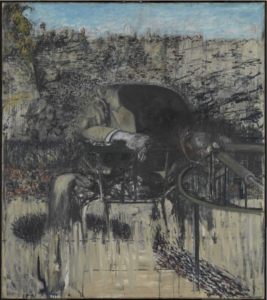Project Management
Independent Research based on lecture
Through The exhibition, Talbot Rice Residents and The Animal Husband toured at Talbot Rice Gallery this week.I had further thoughts. Firstly, studies have proved that compared with a single exhibition form, the high-impact combination of digital media, sculpture, installation, painting, sound, and performance will be more attractive to the audience (Freeman et al., 2015). As a viewer, this week’s two exhibitions struck me visually. In particular, The Animal Husband’s ceramic sculpture Urinating to Protect Demons will greet visitors with the smell of Wolf urine. I want to further study the role of other senses besides vision in art curation. In general, multimedia systems include video and audio content that primarily stimulates visual and auditory stimuli. However, to enhance the sense of reality in multimedia experiences, smell has been incorporated into multimedia systems as it directly stimulates memory and elicits strong emotions (Hou et al., 2020).
Case study:
In 2015, a new exhibition at Tate Britain transformed visual art into a multi-sensory experience, with the Sensorium exhibition comprising four rooms around paintings whose sounds, smells, touches and tastes are all inspired by the artwork. After learning about the relevant art criticism, it turns out that sounds and smells manage to add extra depth to all the works (Gian 2015). With the grace of smell, critic Nicola Davis said, “Suddenly the character emerges as a tired and menacing soul in a vibrant, frantic world (2015).”
https://www.tate.org.uk/whats-on/tate-britain/ik-prize-2015-tate-sensorium

Francis Bacon,Figure in a Landscape(1945)
Individual project and collective project:
For individual projects, through dialogue with artists, curators can discover issues relevant to a certain community and provide opportunities for new projects (Zeiske, 2010). So I’m thinking about whether abandoned Spaces can promote community regeneration and be a way to solve social problems. In addition, I wondered if it was possible to bring other senses besides vision into the abandoned space. As for the collective project, last week we divided the labor and roughly determined the modules of the project book. We divided the project into three themes. The team I was in decided to take the time axis because our projects all reflected the connection between the past and the future. At the same time, I also have general research on the location of my curatorial project.
References:
Francis Bacon, Figure in a Landscape (1945). [online image]. Available at: https://www.tate.org.uk/art/artworks/bacon-figure-in-a-landscape-n05941 [Accessed at :22 March 2024].
Freeman, J. C. & Sheller, M. (2015) Editors’ Statement: Hybrid Space and Digital Public Art. Public art dialogue. [Online] 5 (1), 1–8.
Gian M. Volpicelli. (2015). Touch, smell and eat your art at Tate Britain’s ‘Sensorium’ [Online] Available at: https://www.wired.com/story/tate-sensorium-review-2015/ [Accessed at: 22 March 2024].
Hou, H.-R. et al. (2020) Odor-induced emotion recognition based on average frequency band division of EEG signals. Journal of neuroscience methods. [Online] 334108599–108599.
Nicola Davis. (2015). Don’t just look – smell, feel, and hear art. Tate’s new way of experiencing paintings. [Online] Available at: https://www.theguardian.com/artanddesign/2015/aug/22/tate-sensorium-art-soundscapes-chocolates-invisible-rain [Accessed at:22 March 2024].
Zeiske, C. & Sacramento, N. (2010) “Curatorial Methodology,” in ARTocracy. Germany: Jovis Berlin. p.



Leave a Reply